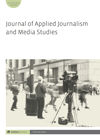
Full text loading...
 , Fadi Safieddine2
, Fadi Safieddine2 , Pardis Pourghomi3
, Pardis Pourghomi3
This article examines the phenomenon of fake news through a survey of university students in the United Kingdom. The survey, composed through a selection of factual and non-factual content/news and complemented through a validation tool, sought to assess the attitudes of these respondents to items of factual misinformation before and after these were verified with the tool. The findings from the survey present online misinformation as a very complex and unfolding phenomenon in terms of user behaviour, particularly when presented with an authentication tool. The majority of respondents failed in identifying factual from fake news posts. While respondents indicated mistrust in using third-party validation tools, the majority indicated a critical need for a verification tool that would support their quest and increase their trust in what they read online.

Article metrics loading...

Full text loading...
References


Data & Media loading...

Publication Date:
https://doi.org/10.1386/ajms_00051_1 Published content will be available immediately after check-out or when it is released in case of a pre-order. Please make sure to be logged in to see all available purchase options.